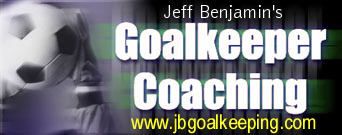
|
"Outstanding keeper instruction. This is a must for goalkeepers and coaches." —Ottawa Internationals S.C. web site, Ottawa, Canada |

|

|
Top |
Goalkeeping Tips, Tidbits and Random Thoughts
An athlete talking to themsleves during competition is hardly a new phenomenon.... The talk does not have to be vocal. By merely thinking you are talking to yourself and sending a message.
-- Tony DiCicco, Goalkeeper Soccer Training Manual
If you have a question, comment or rebuttal you'd like to see addressed here, send me email. I will post your mail to the blog at my discretion unless you specify otherwise.
Nutmegged
Nutmegged. If letting the ball get poked between your legs is embarrassing for a field player, getting megged is tragic for a goalkeeper. But it does happen.In fact, it's happened twice recently to Poland and Liverpool keeper Jerzy Dudek. The first was last week, when DaMarcus Beasley scored the only goal in the USA's 1-0 victory over Poland. The second happened today, when Thierry Henry put one through Dudek in Arsenal's 4-2 win against Liverpool. Both goals looked similar: a through ball on the left side of the box, a player coming in alone, and a left-footed side-foot push on the ground into the net.
Good strikers wait for the goalkeeper to make a move, since they know that the keeper is vulnerable when not set. If the keeper compounds that by having a poor stance (Dudek was leaning back precariously on both goals) the attacker's job is that much easier.
So how do you prevent the meg? When approaching a player who is in the clear (essentially a breakaway situation), keep your weight forward in a good stance. Then, to prevent the gap between your legs, narrow your stance a bit and straddle your feet more front-to-back, with one foot ahead of the other, rather than wide side-to-side. A front-to-back stance will allow you to stay balanced and on your toes while preventing the 5-hole (as it's known in ice hockey) from opening up.
You can also use your hands. As you stalk the attacker, put your trailing hand in between your legs. Your leading hand stays wide and low in the direction the attacker is going.
Labels: Breakaways, Footwork and positioning
When to come off the line
I often get asked, "When should the goalkeeper come off the line?" when dealing with a breakaway? I think the question is the wrong one to be asking first, but there are a few clues to help time when to charge off the line.First, when the attacker has the ball under close control and has the option of taking a shot, the goalkeeper should be as close to the ready position — feet set and not moving — as possible. The time to steal ground is when the ball is away from the attacker's foot, so time your break just as the attacker touches the ball forward.
Second, don't just focus on the ball; watch the shooter's body and use those clues as well. Another cue to come out further is when the attacker puts their head down to focus on the ball (as long as it doesn't look like they're shooting). If you're quick you can close the gap almost completely, and by the time the attacker looks up, the keeper is in their face and there's nowhere to shoot.
However, be aware that the combination of head down/leg back means the attacker is ready to take a shot, and the keeper must immediately stop and set for it.
Reading body language comes from experience, but a little instruction can help players learn to detect the cues faster. I will often have keepers sit behind the goal and watch as myself or another player dribbles, runs and shoots, and have them shout out what they think I am about to do, or what they would do: "Shot!" "Ready!" "Close down!" It allows them to focus on reading the attacker without having to worry about being able to make the save.
Learning what to look for is just as important as learning the physical skills.
Labels: Breakaways
You take the high road and I'll take the low road
There is an old comparison between soccer and rugby: Rugby is a hooligan's sport played by gentlemen; soccer is a gentleman's sport played by hooligans. Although there tend to be more hooligans in the stands some places than on the pitch, there certainly is an etiquette of soccer that coaches need to teach players to observe.The most well-known etiquette rule is to knock the ball into touch to allow an injured player to receive attention. In return, the team receiving the throw will return it to the team that knocked it out, allowing play to resume fairly without requiring intervention from the referee.
Another not-so-well-known rule of etiquette is for a charging striker to leap over a sliding goalkeeper who has clearly won the race to a through ball. This is not necessarily a natural instinct; the first reaction of a player is to continue to go for the ball whether or not the keeper will get there first, and perhaps dislodge the ball. However, this can be dangerous for both keeper and striker -- not to mention the fact that kicking the ball (or, of course, the keeper) after the keeper has gained possession is a foul.
Unfortunately, many young strikers are not taught this, creating very dangerous situations for the goalkeepers they face. As much as we train keepers to protect themselves, there is only so much they can do. If we train the field players as well, we can prevent injuries out on the field. Train the goalkeeper to slide low and stay low and strikers to hurdle the keeper if they are going to win the ball, and it will result in a safer situation for everyone on the field.
Labels: Breakaways
Credit the goalkeeper for forcing the miss
Whenever an attacker is in alone on the goalkeeper, or has an apparently unchallenged shot, and misses the net or shoots right into the keeper, what does everyone think? "How could they miss that?! Right at the keeper again! What lousy finishing!" Very few people think to credit the goalkeeper for forcing the miss.I worked with U12-U14 goalkeepers today on breakaways -- coming out hard, staying on the feet, getting low and slow when close to the shooter, sliding and smothering the ball on a bad touch, and all that. Yet a lot of the "saves" involved an attacker who tried to round the keeper but ended up shooting wide, or shots right into the keeper. The fault of the shooter? Not necessarily. A goalkeeper who comes off the line and plays "big" will force a lot of mistakes, and often the shooter will have nowhere else to put the ball but right at the keeper or outside the frame. I mention it on the breakaway page, but I repeat it here. Give the keeper credit where credit is due!
Labels: Breakaways
Common breakaway mistakes
I did some work yesterday with several U15 keepers on breakaways, and then saw a few of them happen during an adult men's friendly I played in today. I saw two common goalkeeping mistakes during breakaways in both situations that usually led to a goal being scored. This may be a bit of rehash from the breakaway page, but it deserves repeating.The first mistake is going down too soon. Staying on your feet as long as possible is one of Tony Waiter's key considerations, and it certainly is central to the art of goalkeeping. A goalkeeper should only leave their feet as a last resort, and in a breakaway situation should only go for the ball when they're 100% sure they will get it. A keeper who goes down to soon is easy prey for a striker who will simply chip the prone keeper or pull the ball back and round them to deposit the ball in an empty net. England's Michael Owen scored just such a goal against Brazil in their 2002 World Cup quarterfinal match. Brazilian goalkeeper Marcos went down far too early, and Owen simply chipped the ball right down the middle to put England up 1-0.
The second mistake is getting too close to the shooter. Once again, a smart attacker will simply cut around the keeper for the score. After the initial hard charge out, the goalkeeper needs to begin slowing their approach 5-8 yards away from the attacker, and close to no closer than two arm-lengths away. This will put the keeper close enough to cover the angle and avoid being chipped, but still have enough cushion that the attacker can't easily dribble by them. My counterpart who took over for me in goal in the second half of today's friendly made this mistake, and was punished for it. (The game ended in a 2-2 draw, FWIW).
Remember that in a breakaway situation, the goalkeeper is the last defender, and a defender's job is to delay, not necessarily to get the ball. To delay effectively you have to stay on your feet and the proper distance in front of the attacker. That's why my first breakaway training session doesn't even allow for diving or sliding in. Teach them to stay on their feet first and you'll be much better off.
Labels: Breakaways